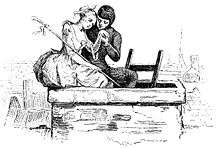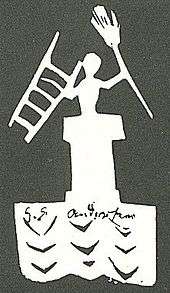The Shepherdess and the Chimney Sweep
| "The Shepherdess and the Chimney Sweep" | |
|---|---|
|
| |
| Author | Hans Christian Andersen |
| Original title | "Hyrdinden og Skorstensfejeren" |
| Country | Denmark |
| Language | Danish |
| Genre(s) | Literary fairy tale |
| Published in | New Fairy Tales. First Volume. Third Collection. 1845. (Nye Eventyr. Første Bind. Tredie Samling. 1845.) |
| Publication type | Fairy tale collection |
| Publisher | C.A. Reitzel |
| Media type | |
| Publication date | 7 April 1845 |
| Preceded by | "The Jumpers" |
| Followed by | "Holger the Dane" |

"The Shepherdess and the Chimney Sweep" (Danish: Hyrdinden og Skorstensfejeren) is a literary fairy tale by Danish poet and author Hans Christian Andersen (1805–1875). The tale follows the romance between a china shepherdess and a china chimney sweep who are threatened by a carved mahogany satyr who wants the shepherdess for his wife. The tale was first published in April 1845 by C.A. Reitzel in Copenhagen, Denmark.
Plot summary
Two china figurines (a shepherdess and a chimney sweep) stand side by side on a table top. They are in love. Their romance is threatened, however, by the carved mahogany figure of a satyr called "General-clothes-press-inspector-head-superintendent-Goat-legs" living on a nearby cabinet who wants the shepherdess for his wife.
The satyr importunes a porcelain Chinaman on the table (who considers himself the shepherdess' grandfather) to give his consent to the marriage. When the Chinaman agrees to the union, the shepherdess and the chimney sweep flee, clambering down a table leg to the floor. They hide in a toy theater, and, when they emerge, discover the Chinaman has fallen to the floor in attempting to pursue them. The lovers then climb with great difficulty through a stove pipe to the roof, sustained in their flight by a star shining high above them.
When the shepherdess reaches the rooftop and gazes upon the world before her, she takes fright at its vastness, and wants to return to the table top. The chimney sweep tries to dissuade her, but, as he loves her greatly, he finally accedes to her wishes and guides her back to the table top. There, the two discover the Chinaman has been repaired in such a way that he cannot press the shepherdess to marry the satyr. The lovers are safe at last.
Publication
The tale was first published by C.A. Reitzel in Copenhagen, Denmark 7 April 1845 in New Fairy Tales. First Volume. Third Collection. 1845. Other tales in the volume include "The Elf Mound", "The Red Shoes", "The Jumpers", and "Holger the Dane". The tale was republished 18 December 1849 as a part of Fairy Tales. 1850. and again on 30 March 1863 as a part of Fairy Tales and Stories. 1863.[1] The tale has been translated into various languages and published around the world.
Analysis
Like Andersen's "The Steadfast Tin Soldier" and "The Sweethearts; or, The Top and the Ball", "The Shepherdess and the Chimney Sweep" is a tale about a romance between two household objects. While "The Steadfast Tin Soldier" and "The Sweethearts" end unhappily, "The Shepherdess and the Chimney Sweep" ends happily-ever-after. Other Andersen tales about household objects include "The Shirt Collar", and "The Teapot".
Adaptations
- Le Roi et l'oiseau, a French animated feature-length film is loosely based on The Shepherdess and the Chimney Sweep.
- Frederik Magle's album The song is a Fairytale (1994), with songs based on Hans Christian Andersen's fairytales performed by Thomas Eje and Niels-Henning Ørsted Pedersen amongst others, includes an adaption of The Shepherdess and the Chimney Sweep.[2]
- The Shepherdess and the Chimney Sweep, an artist's book in an edition of 50 copies, an altered version of Andersen's story, was published in 2012 by Deeply Game Publications. [3]
- There is a sculpture portraying the characters in a scene from the story in Odense, Denmark (the city in which Andersen was born), at the crossroads of Kongensgade and Vestergade.
See also
References
- ↑ "Hans Christian Andersen: The Shepherdess and the Chimney-Sweep". Hans Christian Andersen Center. Retrieved 2009-05-28.
- ↑ "The Song is a Fairytale". magle.dk. Retrieved 2012-07-06.
- ↑ "The Shepherdess and the Chimneysweep". deeplygame.com.
External links
| Wikisource has original text related to this article: |
| Danish Wikisource has original text related to this article: |
- "The Shepherdess and the Chimney Sweep" English translation by Jean Hersholt
- Hyrdinden og Skorstensfejeren Original Danish text

